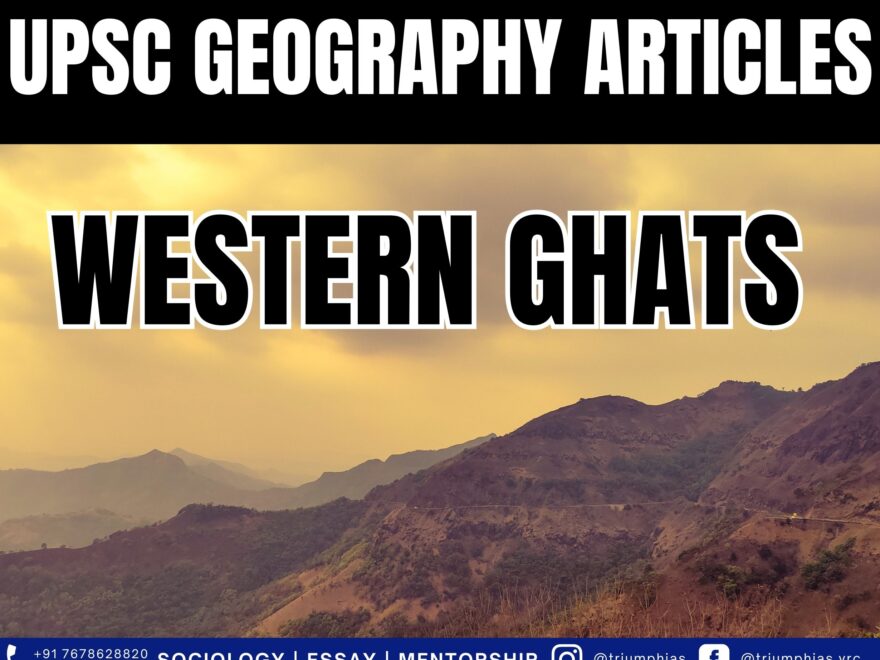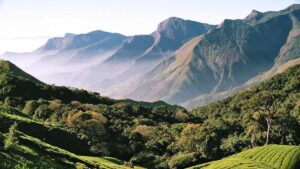Western Ghats
(Relevant for Geography Section of General Studies Paper Prelims/Mains)
Western Ghats
- The Western Ghats, also referred to as the Sahyadri Hills, are renowned for their abundant and distinct collection of plant and animal species.
- The range is named Sahyadri in northern Maharashtra and Sahya Parvatham in Kerala. The narrow coastal plain situated between the Western Ghats and the Arabian Sea’s northern section is termed the Konkan Coast.
- The central part is denoted as Kanara, while the southern part is recognized as the Malabar region or the Malabar Coast. The foothill area to the east of the Ghats in Maharashtra is known as Desh, while the eastern foothills of central Karnataka state go by Malanadu.
- In the southern region, the range is identified as Nilgiri malai in Tamil Nadu. It holds the status of a UNESCO World Heritage Site. Due to its remarkable biological diversity and endemic species, it is considered one of the world’s eight hotspots of biological diversity.
Two perspectives exist concerning the Geology of the Western Ghats.
- The Western Ghats’ mountains are classified as Block Mountains, originating from the downward bending of a land segment into the Arabian Sea.
- Alternatively, the mountains of the Western Ghats are not authentic mountains, but rather the faulted boundary of the Deccan Plateau.
- Prominent rock types present in the area encompass Basalt, charnockites, granite gneiss, khondalites, leptynite, and metamorphic gneisses, along with sporadic instances of crystalline limestone, iron ore, dolerites, and anorthosites.
Topology
- The Western Ghats span from the Satpura Range in the north, extending southward beyond Goa, traversing Karnataka, Kerala, and Tamil Nadu, culminating at Kanyakumari where they meet the Indian Ocean.
- The Niligiri ranges, situated southeast of Mysore in Karnataka, converge with the Shevaroys (Servarayan range) and Tirumala range further to the east, forming a linkage between the Western Ghats and the Eastern Ghats.
- At its highest point, Anamudi in Kerala stands as the pinnacle of the Western Ghats and is also the loftiest peak in India apart from the Himalayas.
- Rivers originating in the Western Ghats and flowing westward include Periyar, Bharathappuzha, Netravati, Sharavathi, Mandovi, among others.
- On the other hand, the rivers originating in the Western Ghats and flowing eastward encompass three major rivers—Godavari, Krishna, and Kaveri—along with numerous smaller and tributary rivers like Tunga, Bhadra, Bhima, Malaprabha, Ghataprabha, Hemavathi, and Kabini.
Vegetation
- The site’s forests contain some of the finest examples of non-equatorial tropical evergreen forests globally and harbor at least 325 flora, fauna, bird, amphibian, reptile, and fish species that are globally threatened.
- The montane forest ecosystems found at higher altitudes significantly impact the weather pattern of the Indian monsoon.
- Serving as a critical barrier, the Ghats intercept the moisture-laden monsoon winds originating from the south-west during the latter part of summer.
- The tropical and subtropical moist broadleaf forests on the western slopes are characterized by dominant species like Rosewood, Mahogany, and Cedar.
- These slopes remain lush green throughout most of the year, with no set time for the shedding of their leaves.
- The eastern slopes of the Western Ghats are home to both dry and moist deciduous forests, characterized mainly by Teak, Sal, Shisham, and Sandalwood trees.
Wild life
- The Nilgiri marten, brown palm civet, stripe-necked mongoose, Indian brown mongoose, small Indian civet and leopard cat are the small carnivores living in the forests of the Western Ghats.
- Many species are endemic, such as the Nilgiri tahr (Hemitragus hylocrius) and the lion-tailed macaque (Macaca silenus).
Significance
- The Western Ghats feeds a large number of perennial rivers of peninsular India including the three major eastward-flowing rivers Godavari, Krishna, and Kaveri.
- The mountains of the Western Ghats influence the Indian monsoon weather patterns that mediate the warm tropical climate of the region
- Western Ghats along with its geographical extension in the wet zone of Sri Lanka are now also considered one of the eight‚ hottest hotspots‛ of biodiversity
- The Western Ghats are rich in iron, manganese and bauxite ores. The forests of Western Ghats are an important source of timber and support a large number of forest-based industries such as paper, plywood, poly-fibres and matchwood. In parts of their ranges Pepper and cardamom, which are native to the evergreen forests of the Western Ghats have been taken up as plantation crops on a large scale.
- There have been important pilgrimage centres in the region- prominent amongst these being Sabarimalai in Kerala, Madeveshwaramalai in Karnataka and Mahabaleshwar in Maharashtra.
Challanges in western Ghats
- The mining activities have grown rapidly especially in Goa and often in violation of all laws, resulting in serious environmental damage and social disruption.
- Human communities living within and adjacent to protected areas in the Western Ghats are often dependent on extraction of NTFPs to meet a diversity of subsistence and commercial needs.
- Livestock grazing within and bordering protected areas by high densities of livestock (cattle and goats) is a serious problem causing habitat degradation across the Western Ghats.
- Agroforestry systems in the Western Ghats are today dominated by tea, coffee, rubber and monocultures of various species, including the recently introduced oil palm.
- Human settlements where legal and/or traditional rights of land ownership occur both within and outside protected areas all across the Western Ghats and represent a significant landscape level threat.
- Large dam projects in Western Ghats have resulted in environmental and social disruption despite cost benefit analyses and environmental impact assessments being done by the government and companies.
To master these intricacies and fare well in the Sociology Optional Syllabus, aspiring sociologists might benefit from guidance by the Best Sociology Optional Teacher and participation in the Best Sociology Optional Coaching. These avenues provide comprehensive assistance, ensuring a solid understanding of sociology’s diverse methodologies and techniques.
Western Ghats, Sahyadri Hills, biodiversity hotspot, UNESCO World Heritage Site, Nilgiri malai, geology, topography, flora and fauna, montane forests, Indian monsoon, tropical evergreen forests, non-equatorial forests, Nilgiri tahr, lion-tailed macaque, environmental challenges, mining in Goa, agroforestry, pilgrimage centers, dam projects, Western Ghats, Sahyadri Hills, biodiversity hotspot, UNESCO World Heritage Site, Nilgiri malai, geology, topography, flora and fauna, montane forests, Indian monsoon, tropical evergreen forests, non-equatorial forests, Nilgiri tahr, lion-tailed macaque, environmental challenges, mining in Goa, agroforestry, pilgrimage centers, dam projects, Best Sociology Optional Coaching, Sociology Optional Syllabus.

Choose The Best Sociology Optional Teacher for IAS Preparation?
At the beginning of the journey for Civil Services Examination preparation, many students face a pivotal decision – selecting their optional subject. Questions such as “which optional subject is the best?” and “which optional subject is the most scoring?” frequently come to mind. Choosing the right optional subject, like choosing the best sociology optional teacher, is a subjective yet vital step that requires a thoughtful decision based on facts. A misstep in this crucial decision can indeed prove disastrous.
Ever since the exam pattern was revamped in 2013, the UPSC has eliminated the need for a second optional subject. Now, candidates have to choose only one optional subject for the UPSC Mains, which has two papers of 250 marks each. One of the compelling choices for many has been the sociology optional. However, it’s strongly advised to decide on your optional subject for mains well ahead of time to get sufficient time to complete the syllabus. After all, most students score similarly in General Studies Papers; it’s the score in the optional subject & essay that contributes significantly to the final selection.
“A sound strategy does not rely solely on the popular
Opinion of toppers or famous YouTubers cum teachers.”
It requires understanding one’s ability, interest, and the relevance of the subject, not just for the exam but also for life in general. Hence, when selecting the best sociology teacher, one must consider the usefulness of sociology optional coaching in General Studies, Essay, and Personality Test.
The choice of the optional subject should be based on objective criteria, such as the nature, scope, and size of the syllabus, uniformity and stability in the question pattern, relevance of the syllabic content in daily life in society, and the availability of study material and guidance. For example, choosing the best sociology optional coaching can ensure access to top-quality study materials and experienced teachers. Always remember, the approach of the UPSC optional subject differs from your academic studies of subjects. Therefore, before settling for sociology optional, you need to analyze the syllabus, previous years’ pattern, subject requirements (be it ideal, visionary, numerical, conceptual theoretical), and your comfort level with the subject.
This decision marks a critical point in your UPSC – CSE journey, potentially determining your success in a career in IAS/Civil Services. Therefore, it’s crucial to choose wisely, whether it’s the optional subject or the best sociology optional teacher. Always base your decision on accurate facts, and never let your emotional biases guide your choices. After all, the search for the best sociology optional coaching is about finding the perfect fit for your unique academic needs and aspirations.
To master these intricacies and fare well in the Sociology Optional Syllabus, aspiring sociologists might benefit from guidance by the Best Sociology Optional Teacher and participation in the Best Sociology Optional Coaching. These avenues provide comprehensive assistance, ensuring a solid understanding of sociology’s diverse methodologies and techniques. Sociology, Social theory, Best Sociology Optional Teacher, Best Sociology Optional Coaching, Sociology Optional Syllabus.
Best Sociology Optional Teacher, Sociology Syllabus, Sociology Optional, Sociology Optional Coaching, Best Sociology Optional Coaching, Best Sociology Teacher, Sociology Course, Sociology Teacher, Sociology Foundation, Sociology Foundation Course, Sociology Optional UPSC, Sociology for IAS,
Follow us :
🔎 https://www.instagram.com/triumphias
🔎https://www.youtube.com/c/TriumphIAS
https://t.me/VikashRanjanSociology
Find More Blogs
|
Scope of the subject and comparison with other social sciences |
|||
|
|
|
|
Modernity and social changes in Europe |



One comment